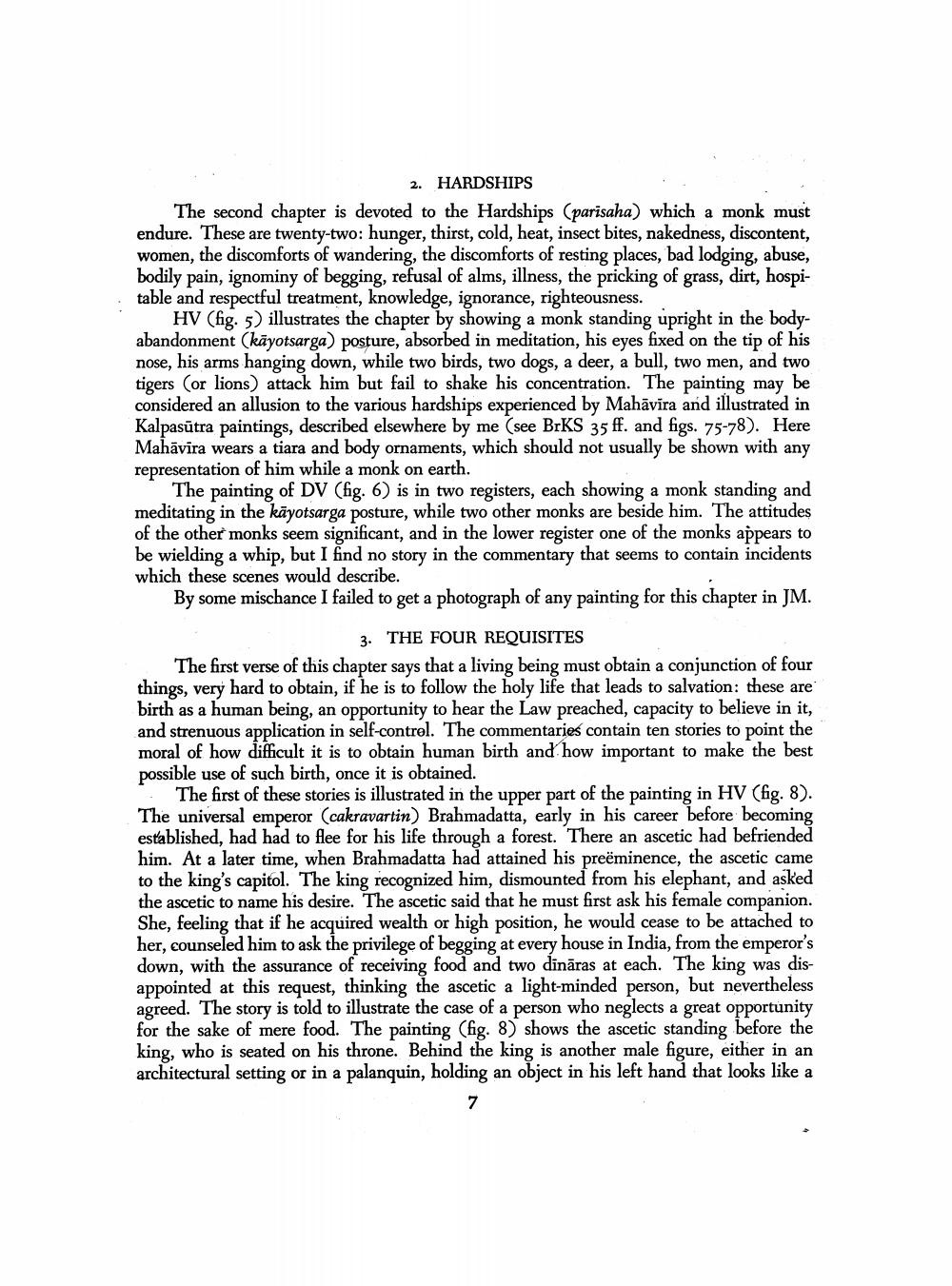________________
ose, his annos han estack him baricus hardships es pece BKS 35
2. HARDSHIPS The second chapter is devoted to the Hardships (parisaha) which a monk must endure. These are twenty-two: hunger, thirst, cold, heat, insect bites, nakedness, discontent, women, the discomforts of wandering, the discomforts of resting places, bad lodging, abuse, bodily pain, ignominy of begging, refusal of alms, illness, the pricking of grass, dirt, hospitable and respectful treatment, knowledge, ignorance, righteousness.
HV (fig. 5) illustrates the chapter by showing a monk standing upright in the bodyabandonment (kāyotsarga) posture, absorbed in meditation, his eyes fixed on the tip of his nose, his arms hanging down, while two birds, two dogs, a deer, a bull, two men, and two tigers (or lions) attack him but fail to shake his concentration. The painting may be considered an allusion to the various hardships experienced by Mahāvīra and illustrated in Kalpasūtra paintings, described elsewhere by me (see BrKS 35ff. and figs. 75-78). Here Mahāvīra wears a tiara and body ornaments, which should not usually be shown with any representation of him while a monk on earth.
The painting of DV (fig. 6) is in two registers, each showing a monk standing and meditating in the kāyotsarga posture, while two other monks are beside him. The attitudes of the other monks seem significant, and in the lower register one of the monks appears to be wielding a whip, but I find no story in the commentary that seems to contain incidents which these scenes would describe.
By some mischance I failed to get a photograph of any painting for this chapter in JM.
3. THE FOUR REQUISITES The first verse of this chapter says that a living being must obtain a conjunction of four things, very hard to obtain, if he is to follow the holy life that leads to salvation: these are birth as a human being, an opportunity to hear the Law preached, capacity to believe in it, and strenuous application in self-control. The commentaries contain ten stories to point the moral of how difficult it is to obtain human birth and how important to make the best possible use of such birth, once it is obtained.
The first of these stories is illustrated in the upper part of the painting in HV (fig. 8). The universal emperor (cakravartin) Brahmadatta, early in his career before becoming established, had had to flee for his life through a forest. There an ascetic had befriended him. At a later time, when Brahmadatta had attained his preëminence, the ascetic came to the king's capitol. The king recognized him, dismounted from his elephant, and asked the ascetic to name his desire. The ascetic said that he must first ask his female companion. She, feeling that if he acquired wealth or high position, he would cease to be attached to her, counseled him to ask the privilege of begging at every house in India, from the emperor's down, with the assurance of receiving food and two dināras at each. The king was disappointed at this request, thinking the ascetic a light-minded person, but nevertheless agreed. The story is told to illustrate the case of a person who neglects a great opportunity for the sake of mere food. The painting (fig. 8) shows the ascetic standing before the king, who is seated on his throne. Behind the king is another male figure, either in an architectural setting or in a palanquin, holding an object in his left hand that looks like a
he Weinlich.
Bu toploto




